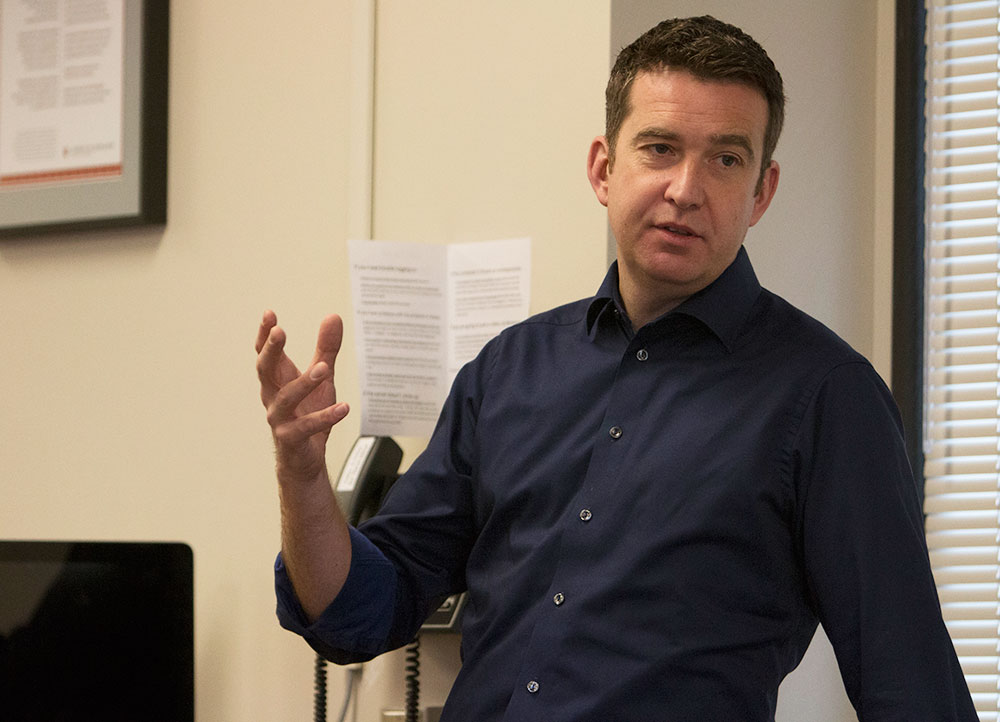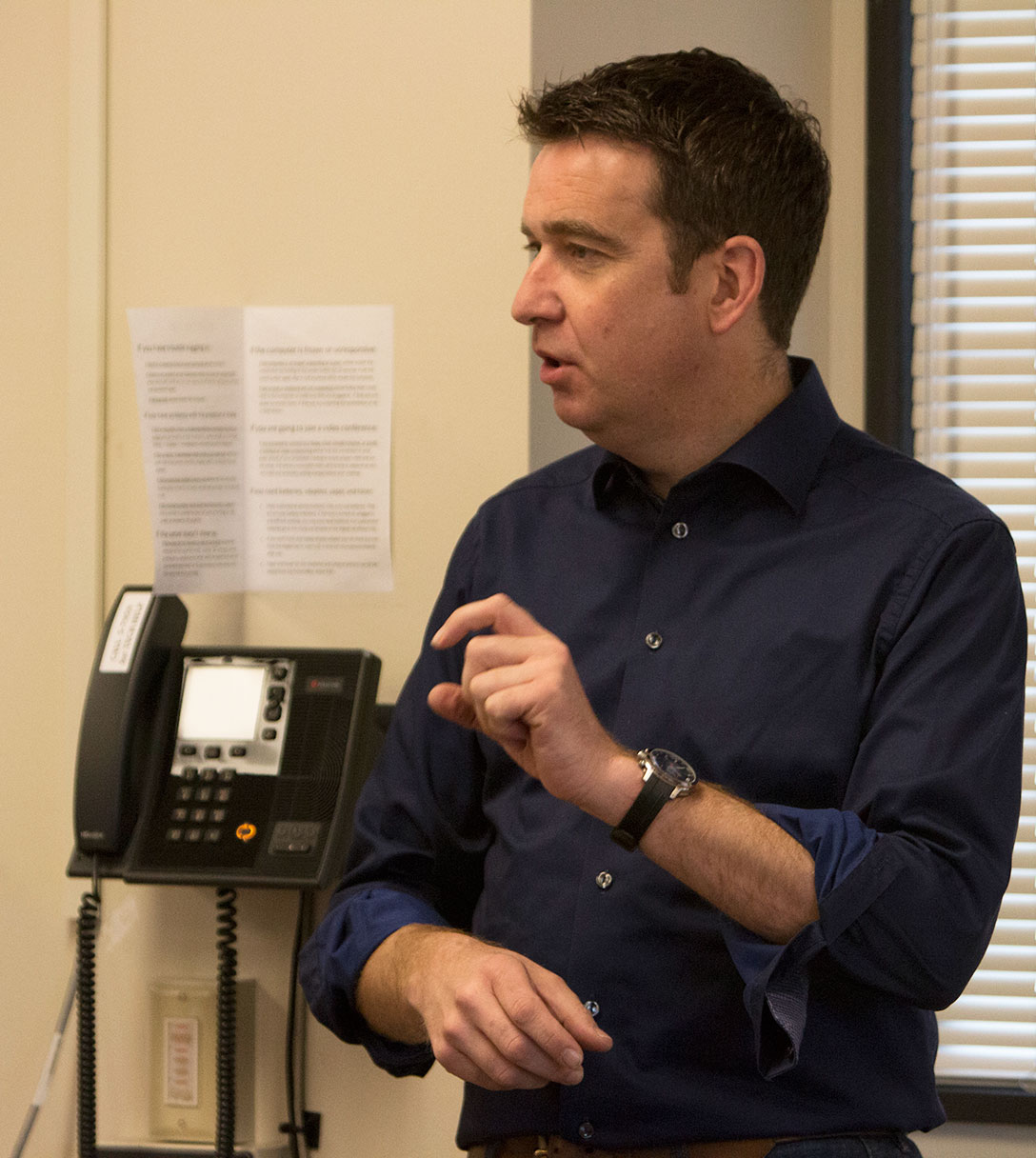Storyful founder describes value of social media as news

Storyful founder Mark Little can pinpoint when he was inspired to create his company, which distributes social media content to news organizations.
That idea first came to him following the 2009 Iranian elections, he said during his talk Wednesday to professor of practice Elaine Monaghan’s J560 Media and the Message Maker class.
“Iran was my particular story of interest,” said Little, then a news reporter and anchor for RTE, the public broadcast network in Ireland. “I would go there every year, twice a year.
“Any foreign correspondent will tell you that there’s a specific place in the world that gets under your skin, that you think about, that you dream about, that you can’t get out of your head,” Little said. “And Iran was that kind of place.”
But when Iranians took to the streets protesting what they thought were rigged elections, Little couldn’t go because RTÉ had just gone through a round of budget cuts.
“I sat in my home in Dublin, Ireland, watching on Twitter, which was completely new to me at that stage, all of these images of these places I knew in Tehran coming in,” Little said. “But listening on the television to this very respected BBC correspondent telling me ‘there are reports of a shooting at Valiasr Square.’”
Valiasr Square is in northern Tehran, and it was an epicenter of the protests.
“But I could see on Twitter bodies being taken off the square,” Little said.
That sort of side-by-side comparison of legacy media and social media, almost competing to get news coverage out, made Little realize the power of social media.
“So here’s this respected journalist, with maybe 30 or 40 years in foreign correspondence, with news that’s completely out of date,” he said of the BBC correspondent. “And here’s this 17-year-old, telling me news that’s completely up to the minute, authentic, raw and truthful. That was sort of a light bulb moment for me.”
Little had the same sort of moment after news broke of Michael Jackson’s death.
“I was at a wedding in the west of Ireland on the banks of the river Shannon, and at half past nine, I saw all of the people with mobile phones cornered by the bar.”
He recalled the buzz: “What’s going on?” “Michael Jackson just died.” “How do you know?” “Twitter just told me.”
“I remember by 10 o’clock, everyone knew,” Little said. “I realized afterwards that the LA Times didn’t report the death of Michael Jackson officially until 10:15 Irish time. So there we were, dancing to Thriller, 20 minutes before the local paper in L.A. reported the death of the King of Pop,” he said.
Little left RTÉ in December 2009 and founded Storyful in 2010. He sold the company in 2013 to News Corp, where he now works as director of innovation.
“In hindsight, it was a midlife crisis,” Little said.
And the first year was rough for Little. He had to raise 500,000 euros during the Irish economic collapse. His former colleagues signed onto the project, giving it vital support and experience. Storyful landed its first contract with ABC News a year later.
Storyful acquires content uploaded to social media and distributes it to media outlets. That process takes four steps: Storyful identifies who produces content, verifies its veracity, buys the rights to it and licenses it to media outlets ranging from The New York Times to the Ellen Degeneres Show.
“It used to be, as journalists, we had the monopoly on information,” Little said. “Today, you only need a camera phone and a connection to a social media network to be a storyteller.”
But that results in a flood of news. And that’s where Little thinks Storyful fills a market.
“Ninety-nine percent of content loaded on social network has no value. It’s cute cats, what you had for breakfast, your kid’s first birthday,” he said. “It’s not earth-shattering.”

Little said companies like Storyful identify the sliver of valuable information on social media. But Little also wants Storyful to stop bogus stories in their tracks.
“We as journalists now have a key role in stopping a story, and that’s what Storyful does.”
He cited the 2013 hacking of The Associated Press Twitter account. The compromised account tweeted: “Breaking: Two Explosions in the White House and Barack Obama is injured.”
“It took us about 40 seconds for us to say ‘that’s not true,’” Little said. “There were some forensic things we did.”
For example, analysts compared the tweet to AP’s style. AP always refers to Barack Obama as “President” Barack Obama and capitalizes the word “breaking” in its tweets.
“Sometimes you don’t want a scoop. Sometimes you want to stop a story,” Little said.
But when Storyful does get a scoop — when it finds a video on social media that’s potentially valuable — it takes on the task of verifying it.
“Which is good old fashioned journalism,” Little said.
That verification may mean checking shadows to see what time of day it is, or checking landmarks in the background against Google Maps or Google Earth. And in some regions of the Middle East, a stream flowing in the background means it’s winter, because there wouldn’t be water there during the summer.
“There has to be skepticism because there are so many bad things about social media,” Little said. “There’s never been a better way to spread a hoax. But I would argue there’s never been a chance to be more authentic, either.”

